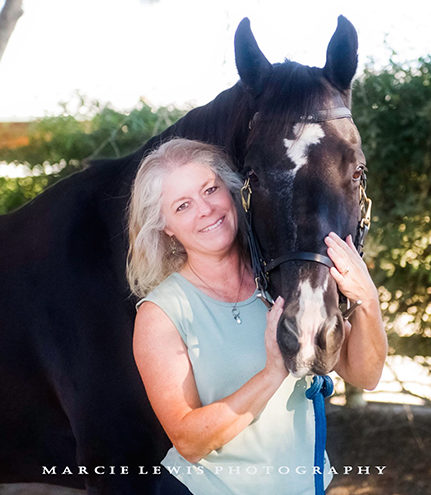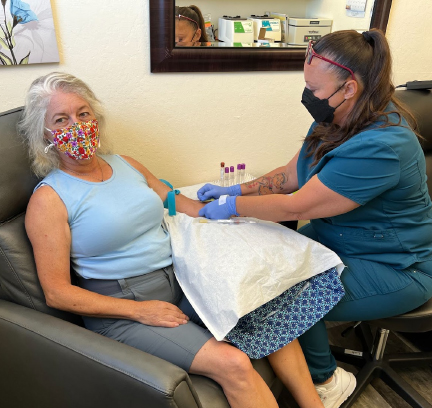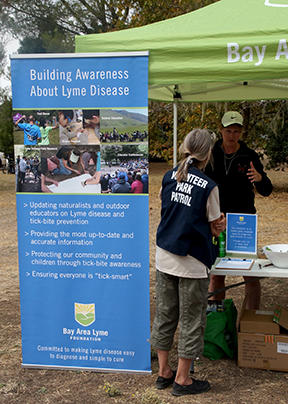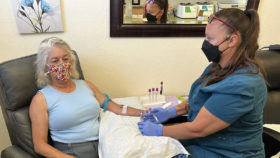BAL Spotlights Series
In June of this year, Lyme Disease Biobank (LDB), led by Principal Investigator Liz Horn, PhD, MBI, conducted sample collection days at our partner site, Gordon Medical Associates, in San Rafael, CA. During the two-day event, we took the opportunity to sit down and talk with participants, hear their Lyme disease stories, and learn what motivated them to donate blood and urine samples to LDB.
Sarah Reid’s Lyme story is not dissimilar to the stories of many Lyme patients in California. She never saw a tick; she never had a rash; and for a very long time—despite countless doctors’ appointments, interventions, tests, and hours of research—she had absolutely no diagnosis for her bewildering kaleidoscope of symptoms. When she finally received confirmation from lab tests ordered by Gordon Medical Associates that she indeed had Lyme and Bartonella, the news was a massive relief initially. She finally had answers. However, as the diagnosis sunk in, it sparked reflection on her lifelong health struggles and launched her into a new world of confusion, frustration, and decision-making as she learned to navigate and manage her Lyme.
 “I live in Sonoma County, and I’ve lived here since 1967. My life revolves around horses, volunteering for the horse trail patrol and being active in my local regional and state parks and preserves. We are and always have been an outdoor type of family. As a child, I was outside all the time. My family’s focus was nature. We hiked. We went on day trips out to the coast. I did day camps in the summertime. I did weekend camps during the school year, helping with our girl scout council—I was very active in my local girl scout troop—and my dad was a teacher at family camp during the summertime. I don’t remember ever taking a tick off of me.”
“I live in Sonoma County, and I’ve lived here since 1967. My life revolves around horses, volunteering for the horse trail patrol and being active in my local regional and state parks and preserves. We are and always have been an outdoor type of family. As a child, I was outside all the time. My family’s focus was nature. We hiked. We went on day trips out to the coast. I did day camps in the summertime. I did weekend camps during the school year, helping with our girl scout council—I was very active in my local girl scout troop—and my dad was a teacher at family camp during the summertime. I don’t remember ever taking a tick off of me.”
“As a child, I was outside all the time. My family’s focus was nature. I don’t remember ever taking a tick off of me.”
“Fast forward to 2012 or 2013. I was in a job where I was under a lot of stress in a challenging physical and mental environment. I got very sick and had a lot of terrible headaches. I was working four days a week Sunday through Wednesday and every Thursday I ended up in my Kaiser GP’s office saying, ‘I’ve got another very bad headache.’ My GP finally looked at me and said, ‘Something is going on with you. Let’s put you on disability for three months and then review the situation because we need to make you feel better.’ My doctor put the paperwork through immediately.”

Coincidentally, Sarah had an appointment to see a craniosacral therapist at Gordon Medical Associates in San Rafael the very next day. Referred by a horseback riding friend who HAD been diagnosed with Lyme, Sarah had been describing her battles with the debilitating headaches and other odd symptoms to her friend. Sarah started seeing the recommended therapist almost every week as the sessions seemed to alleviate at least some of her symptoms.
Sarah’s GP renewed her disability after three months because, although she was a little better, she was still far from well. One day the craniosacral therapist asked her if she had ever been tested for Lyme disease. After working on Sarah for this extended period, the therapist felt that Sarah was responding exactly like other clients who had been diagnosed with Lyme. Working at Gordon Medical Associates meant the therapist had seen many Lyme-positive patients, and she recommended Sarah get tested. So, although Sarah was skeptical of the hypothesis, she contacted her GP at Kaiser and asked if she could get a Lyme test.
Sarah was quick to point out that she has had the same GP at Kaiser for many years and that they have an excellent relationship, despite Kaiser’s intractability with regards to Lyme disease patients. “My GP had known me for many years. She was willing to do anything in her power to help me get better. She put the orders in for the Lyme test, but of course because it was tested by Kaiser’s lab and they adhere to strict test interpretation guidelines stipulated by the CDC, the results came back as negative.” Sarah tried to get an appointment with Kaiser’s chronic disease department, but they wouldn’t talk to her. “The feedback was: ‘You don’t have Lyme.’ So that was the end of the conversation.”
But then, Sarah’s test from Gordon Medical Associates came back most definitely positive for Lyme and Bartonella.
She took the results of this independent lab test to her Kaiser GP, and Sarah recounted her GP’s response ruefully. “My GP commented, ‘You know what, Sarah, I totally believe you as a physician. I believe these test results. I wish I could treat you for this, but my hands are tied by Kaiser. I can only treat you symptomatically but can’t diagnose and treat you for Lyme. They simply don’t believe in it.’ I thanked my doctor, understanding her difficult situation. She could order additional tests, blood work, thyroid analysis, or a parasite test—which were all covered by Kaiser—but there could not be a Lyme connection.”
Like many Lyme patients, Sarah then embarked on a search for a local Lyme-literate doctor who would treat her for her persistent Lyme and Bartonella. Having found Dr. Lois Johnson in Sebastopol, Sarah’s Lyme journey got underway and resulted in an ongoing, multi-pronged, functional medicine approach, combining tinctures, supplements, herbals, and other therapies depending on her ever-changing symptoms. “I took antibiotics for a long time and although they seemed to help initially, overall my experience with antibiotics was mixed,” she explained.
“I believe in science and research. It’s painless to give urine and have your blood drawn, and maybe my contribution will help somebody else who gets Lyme in the future.”
Sarah discovered that her body did not respond favorably to antibiotics as a long-term approach, especially when a freak horseback riding accident landed her in the hospital.
“After the riding accident, I woke up in the hospital in the ER, and the doctors started me off on extreme painkillers and muscle relaxants because I had severely injured my back, and I also had a traumatic brain injury. The medications and supplements that I was taking for Lyme reacted with the conventional medicines the ER doctors gave me, and I suffered serious drug reactions. At the time, the doctors at Kaiser were confused. They concluded, ‘Oh no, you can’t be reacting to these drugs,’ but they did not offer any other solutions. I realized that I needed to heal myself from this accident in my own way, plus I had a traumatic brain injury! I focused 100% on my healing for well over six months.”
Sarah ultimately had to have back surgery and has struggled with chronic physical pain ever since. But, in a strange twist of fate, the horseback riding accident caused her to reflect even more critically over her life. “In hindsight, I realized that I had been dealing with chronic physical pain all of my life. I remembered that my debilitating headaches actually started in the eighties when I was in high school! These were headaches that would go on for days and put me in the ER numerous times. I even saw a chiropractor for them when I was a teenager. So, I do wonder whether I did, in fact, contract Lyme and Bartonella at a much younger age and if Lyme disease has been the source of many of my physical and neurological issues.”
“In hindsight, I realized that I had been dealing with chronic physical pain all of my life. I do wonder whether I did, in fact, contract Lyme and Bartonella at a much younger age…”

Despite her ongoing health challenges and constant efforts to manage her Lyme symptoms, Sarah continued to work and volunteer for state and regional parks, and that’s how she learned about Bay Area Lyme Foundation’s work. In 2015, Bay Area Lyme sponsored a mountain bike race at Annadel State Park in Santa Rosa—Sarah’s backyard and a former workplace. “Bay Area Lyme was at Annadel with an information table. I was so excited and relieved that finally somebody was educating the public about the risks of tick-borne illnesses.”
From this initial contact, Sarah signed up for Bay Area Lyme’s mailing list, receiving the quarterly newsletter. She alerted people to the Foundation’s website and its wealth of informational resources. After seeing information from Bay Area Lyme about the Lyme Disease Biobank (LDB) with links about how to participate, she decided to sign up immediately. Sarah reasoned, “I believe in science and research. Donating to the Biobank was a little thing I could do to support Bay Area Lyme and the Biobank. It’s painless to give urine and have your blood drawn, and maybe my contribution will help somebody else who gets Lyme in the future.”
For Sarah, donating the blood and urine samples was an easy thing to do, but what took her by surprise was her response as she prepared to drive home to Santa Rosa. “I got emotional and tearful when I walked out to the parking lot at Gordon Medical Associates. Everybody involved in the Biobank program was listening and was there for us. I felt I had been heard with compassion and empathy. People with Lyme feel as if we’ve been whistling into the wind for years. I had this profound wave of relief: Somebody believes us; somebody supports us; and they know Lyme isn’t just a ‘hippie doctor’ disease.”
As she turned on her radio and started driving back to Santa Rosa, her sense of relief and gratitude shifted to one of anger and frustration as she listened to the news.
When she arrived home, Sarah sat down at her computer and posted this message on her personal Facebook page and in her Lyme Disease support group:
“I am posting this not as a political rant or anything. I mean it to be educational and to raise awareness.
Yesterday I was honored to be a part of Bay Area Lyme Foundation’s Lyme Disease Biobank study. Honored because I have long been eager to be a part of research into this disabling and life-changing disease. On my way back to Santa Rosa from San Rafael yesterday, I was listening to NPR news on KQED Radio. I heard a news report about how the WHO is focused on Monkeypox because there have been at least 3,200 cases across the globe. Stay with me here …
What struck me about this is that the WHO has this on the radar. Yet, think about it: how many confirmed Lyme-positive cases are there just here, in the North Bay Area, yet … nothing is being done? Then I just came across this article with the headline that 300,000 vaccines will be made available in the US within weeks. WEEKS.
Think about it. For a disease that, yes, is communicable between humans by skin-to-skin contact, causing a skin rash and discomfort. Yet we have known about Lyme Disease and the spread of the bacteria and co-infections and the acute need for proper diagnosis and treatments for decades, too. For decades the US medical establishment has known about chronic symptoms of Lyme Disease. DECADES.
Monkeypox was first diagnosed in 1958. It started to spread in the 1970s (per WHO). It is only recently that it has appeared in areas of the globe not noticed before. Lyme was first described in 1976 and has spread across the entire continent of North America. When Dr. Burgdorfer described this, the families had been struggling all through the 1960s as well. This is on the www.bayarealyme.org/about-lyme/history-lyme-disease website: “In 2012, Lyme disease was included as one of the top ten notifiable diseases by the Centers for Disease Control and Prevention (CDC).” And “Lyme disease is one of the fastest-growing vector-borne infections in the United States with ~500,000 new cases of Lyme disease each year.”
So why is this NOT on the radar of the CDC, DHS, WHO to name a few? Let alone a vaccine or treatment? I wonder: if I needed a monkeypox vaccine, I would probably get it with no charge and no co-pay under my healthcare provider. If diagnosed with monkeypox I bet I could get treatment. But I can’t even get reputable lab results recognized for treatment of Lyme Disease or other tick-borne bacteria (co-infections).
Author: Sarah Reid, June 28, 2022
As someone who has spent her life in the outdoors, Sarah is concerned that as more people head outside to enjoy nature—especially during and after the Covid-19 pandemic—more and more people are going to be exposed to ticks and tick-borne diseases.
“Sadly, we hear stories like Sarah’s every day,” comments Linda Giampa, Executive Director, Bay Area Lyme Foundation. “Our goal is not only to develop accurate diagnostics and reliable, effective therapeutics for Lyme disease, but also to educate the public about the considerable risks of tick-borne infections. We salute every person who has participated in our Biobank program. Scientific breakthroughs are happening right now in the field of Lyme disease research because people like Sarah were willing to donate blood, urine, and tissue to the LDB. Lyme patients are helping us to unravel some of the most intractable challenges of this terrible disease.”
Read more about Lyme Disease Biobank and how to get involved by visiting our website
Learn how to participate in future sample collections in San Rafael.
This Bay Area Lyme Foundation blog is part of our BAL Spotlights series. Bay Area Lyme provides reliable, fact-based information so that prevention and the importance of early treatment are common knowledge. For more information, including our research and prevention programs, go to www.bayarealyme.org.

My symptoms of Lyme disease occurred in 2017, but was diagnosed in 2019. I had severe symptoms ranging from headache, fatigue, and a characteristic skin rash called erythema migrans, i had difficulty with my joints, heart, and my nervous system.. I was given medications which helped but only for a short burst of time, then I decided to try alternative measures and began on Ayurvedic treatment from a natural herbs centre, It has made a tremendous difference for me (Visit www natural herbs centre com)
I know Sarah and have spent many hours working with her at our parks and know first hand what she deals with day in and out in regards to her Lyme struggles. We have also spent many those hours sharing frustration with the intractability (great word!) of the conventional western medicine establishment. We both wish there were more options and a wider range of acceptance that there are still things in the medical world that don’t fit molds set down by the CDC and WHO and other “medical decision makers”.
It makes me happy and optimistic that there are resources for those with Lyme and other similar diagnoses. Thank you Sarah for sharing your story!